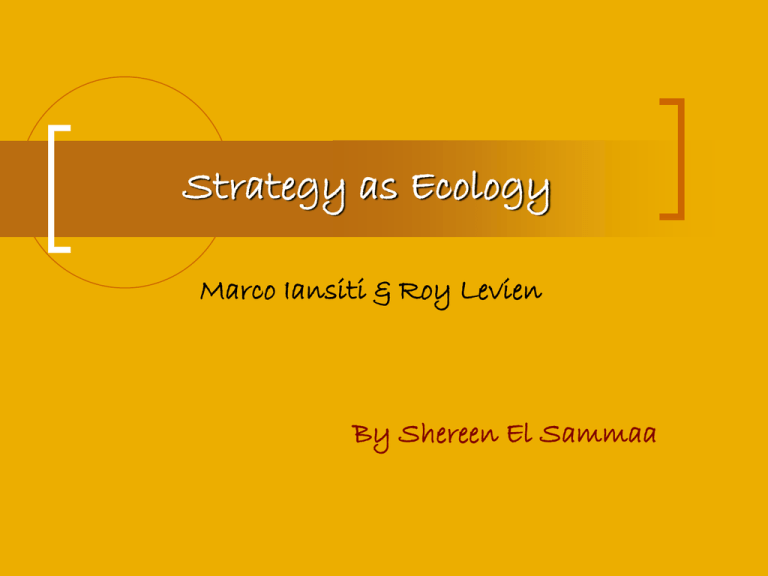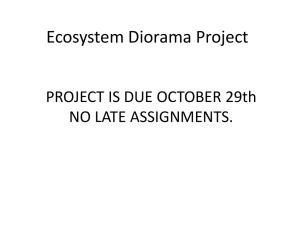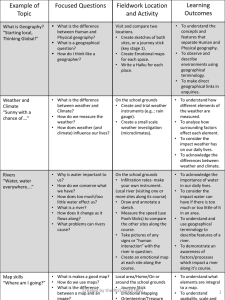Strategy as Ecology
advertisement

Strategy as Ecology Marco Iansiti & Roy Levien By Shereen El Sammaa Outline Business ecosystem-Briefly Assessing health of your company’s ecosystem-How healthy are you? Determining your place in it-Keystone, Dominator, Niche Player Developing a strategy to match your role in it-Match your strategy to your environment How useful an Analogy? Implications of Ecosystem perspective What is a Business Ecosystem? Typical business ecosystem includes: Traditional suppliers & distributors Companies to which you outsource business functions Institutions that provide you w/ financing Firms providing technology needed to carry out your business Makers of complementary products Competitors & Customers→ when their actions & feedback affect your processes & products Assessing Your Ecosystem’s Health So what is a healthy ecosystem? What are the indications that it will continue to create opportunities for each of its domains & for those who depend on it? Three Critical Measures of Health: Productivity Robustness Niche Creation So… How can you promote the health & stability of your own ecosystem, thereby helping to ensure your company’s well being? It depends on your role-current & potential-within the network The three main roles Keystones, Dominators, and Niche players Match your Strategy to Your Environment Company’s choice of ecosystem strategy governed primarily by the kind of company it is or aims to be Choice also be affected by business context in which it operates: General level of turbulence Complexity of its relationships w/ others in the ecosystem If your business… faces rapid & constant change, & by leveraging the assets of other firms, can focus on a narrowly & clearly defined business segment → Niche strategy is at the center of a complex network of asset-sharing relationships & operates in a turbulent environment → Keystone Strategy If your business… relies on a complex network of external assets but operates in a mature industry → Physical Dominator Strategy chooses to extract maximum value from a network of assets that you don’t control → Value Dominator Strategy is a commodity business that operates in a stable and mature environment& operates relatively independently of other organizations → Ecosystem Strategy is irrelevant (although that may change soon) How useful an Analogy? Strong parallels between Business Networks & Biological Ecosystems-large number of loosely interconnected participants that depend on one another for their effectiveness & survival Ecosystem healthy → individual participants will thrive and vice versa Crucial hubs that assume the keystone function of regulating ecosystem health Keystone-Sea Otter, Dominator- sea urchins, Niche Players-variety of invertebrates and plants How useful an Analogy? (cont’d) Analogy isn’t perfect-sunlight & nutrients vs. technology But to be perfect, an analogy has to be so simplistic that it would offer little real insight Use of term “ecosystem” rather than “community” → clearly signals that we are discussing a complex system & working w/ a biological analogy Vivid terminology helps managers focus on features of modern business networks, often ignored by conventional theories Underlie many drivers of success & failure Implications of Ecosystem Perspective Central importance of interdependency in business Importance of integration Broad scattering of innovation across a healthy ecosystem Taking action w/o understanding impact on its many neighboring business domains, or on ecosystem as a whole More Than Strategy Implications ripple throughout whole organization, not only strategies No longer possible to design or conceive of a product in isolation e.g. music players, cameras, computers, etc… all merging functions Creates opportunities for innovation & product development In a healthy ecosystem → New products can leverage the capabilities provided by existing products The fact is that… Users no longer care much about identity or features of their products, only about how they fit in with & enhance the systems of which they are a part Thank You








